Impact of Arts and Culture on Fort Myers’ Economy
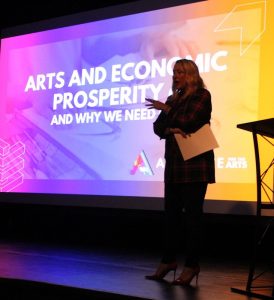 In October of 2023, the Americans for the Arts released its Arts & Economic Prosperity 6 survey results.
In October of 2023, the Americans for the Arts released its Arts & Economic Prosperity 6 survey results.
AEP6 makes clear that when a county or municipality funds the arts, it is investing in an industry that stimulates the economy, supports local jobs and contributes to building a healthy and vibrant community. And in Fort Myers, arts and culture is more than food for the soul. It also puts food on the table for scores of people who live and work in the City.
.
Total Economic Activity
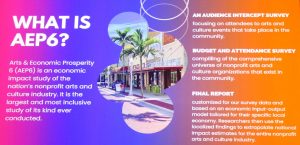 According to the data collected by the Lee County Alliance for the Arts from 16 participating organizations, the nonprofit arts & cultural sector generated $98.7 million in economic activity during 2022. [The AEP6 for the City of Fort Myers states that 26 arts and culture organizations
According to the data collected by the Lee County Alliance for the Arts from 16 participating organizations, the nonprofit arts & cultural sector generated $98.7 million in economic activity during 2022. [The AEP6 for the City of Fort Myers states that 26 arts and culture organizations 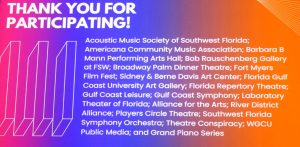 participated in the survey, but only 16 of the venues identified on page 53 of the report actually participated.]
participated in the survey, but only 16 of the venues identified on page 53 of the report actually participated.]- The 16 arts and culture organizations that participated in the American for the Arts’ AEP6 survey were (alphabetically): Acoustic Music
 Society of Southwest Florida, Americana Community Music Association, Broadway Palm Dinner Theatre, Florida Arts (Sidney & Berne Davis Art Center), Florida Gulf Coast University Art Gallery, Florida Repertory Theatre, Fort Myers Film Festival, Grand Piano Series, Gulf
Society of Southwest Florida, Americana Community Music Association, Broadway Palm Dinner Theatre, Florida Arts (Sidney & Berne Davis Art Center), Florida Gulf Coast University Art Gallery, Florida Repertory Theatre, Fort Myers Film Festival, Grand Piano Series, Gulf 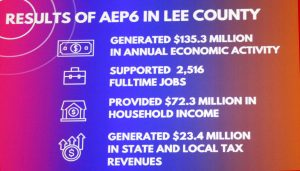 Coast Leisure, Gulf Coast Symphony Orchestra, Laboratory Theater of Florida, Lee County Alliance for the Arts, River District Alliance, Southwest Florida Symphony Orchestra, Theatre Conspiracy, and WGCU Public Media.
Coast Leisure, Gulf Coast Symphony Orchestra, Laboratory Theater of Florida, Lee County Alliance for the Arts, River District Alliance, Southwest Florida Symphony Orchestra, Theatre Conspiracy, and WGCU Public Media. - No estimates or extrapolations were made to account for
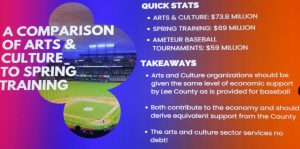 the 96 arts & culture organizations that did not participate in the AEP6 survey.
the 96 arts & culture organizations that did not participate in the AEP6 survey. - Consequently, the $98.7 million in economic activity for 2022 understates the actual amount of economic activity generated by the nonprofit arts & culture sector of Fort Myers’ local
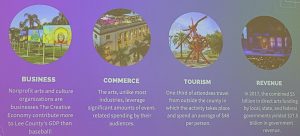 economy.
economy. - Note should also be taken that the economic activity generated by the 16 participating arts & culture organizations was adversely affected in 2022 by the COVID-19 pandemic, which changed the attendance habits of many
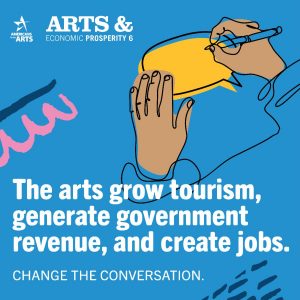 art show, art festival and theater patrons. While audiences are slowly returning, nonprofit arts and culture organizations nevertheless report just a 2/3 to ¾ return rate as of 2023.
art show, art festival and theater patrons. While audiences are slowly returning, nonprofit arts and culture organizations nevertheless report just a 2/3 to ¾ return rate as of 2023. - Hurricane Ian also exercised an adverse impact on attendance rates during the last quarter of 2022. Not only did the damages and outages that followed the storm force the cancellation of art shows, exhibitions and performances as affected organizations made repairs to their facilities, it also
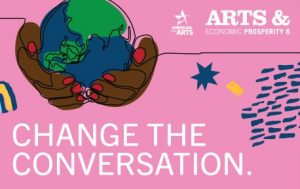 negatively affected the interest of patrons and their physical and financial ability to attend post-storm scheduled events.
negatively affected the interest of patrons and their physical and financial ability to attend post-storm scheduled events. - Finally, AEP6 only measures the economic activity generated primarily by the nonprofit arts & culture sector. It does not include economic activity generated by
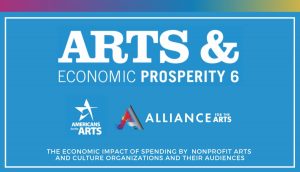 individual artists or the majority of the for-profit arts and entertainment section (although Broadway Palm Dinner Theatre qualified to participate in the survey).
individual artists or the majority of the for-profit arts and entertainment section (although Broadway Palm Dinner Theatre qualified to participate in the survey).
Direct Spending by Nonprofit Arts & Cultural Organizations
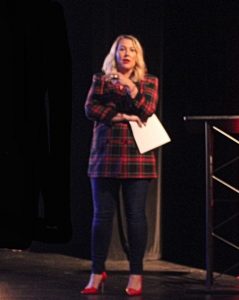 Of the $98.7 million in total economic activity generated by the nonprofit arts & cultural sector, the 16 arts & culture organizations that participated in the study reported aggregate expenditures of $50.4 million in 2022.
Of the $98.7 million in total economic activity generated by the nonprofit arts & cultural sector, the 16 arts & culture organizations that participated in the study reported aggregate expenditures of $50.4 million in 2022.- These 16 participating organizations employed 1,128 local residents and paid them $32,115,337 in household income.
- Arts and culture organizations provide rewarding employment for more than just arts administrators, artists and curators. They also employ box office staff, ushers, tour guides, custodians, maintenance staff, builders, plumbers, electricians, graphic designers, printers, marketing and publicity personnel and
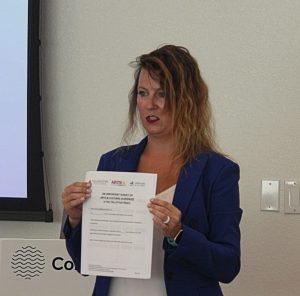 an array of people in occupations spanning many other industries.
an array of people in occupations spanning many other industries. - These workers, in turn, used the income they earned to pay their mortgages or rent, premiums for home and auto insurance, utilities (electric, water, telephone and internet), and living expenses (groceries, apparel and household goods and services) as well as make discretionary leisure and entertainment expenditures.
- Arts & culture jobs are highly local. Therefore, dollars spent on human resources typically stay within the community longer, thereby producing a greater local economic impact.
- These 16 participating organizations also contributed $1,955,481 toward local government revenues (city and county property taxes, licenses and other fees), as well as $1,727,737 in state government revenues (in the form of sales tax and other remittances).
- Many of the arts & culture organizations who participated in the AEP6 survey also contributed personnel and other resources (including facility space) to help collect and distribute water, food, clothing and cleaning products to community members in the aftermath of Hurricane Ian.
Event-Related Expenditures by Arts & Culture Audiences
- Of the $98.7 million in total economic activity generated by the arts & cultural sector in 2022, $48.3 million was attributable to event-related expenditures by the audiences who attended the art festivals, art shows and exhibitions, theater and other performances, concerts, and other programming they produced.
- When people attend a cultural event, they often make an outing of it – dining at a restaurant, paying for parking, a ride share or public transportation, purchasing a souvenir or other item from a nearby retail store, enjoying a drink or dessert after the show and paying for child or pet care when they return home.
- This $48.3 million in event-related expenditures does not include either the price of admission or the cost of any food and beverages that may have been purchased on site.
- So clearly, the local businesses that cater to or are proximately located near arts and culture audiences reap the rewards of this economic activity.
- But there’s more: these expenditures also supported an additional 804 full-time, part-time and seasonal jobs in 2022, resulting in the payment of $21,491,453 in household income, $1,406,799 in local government revenue and $1,233,233 in state revenue.
- To measure the impact of spending on arts and culture audiences in Fort Myers, data were collected from 1,143 attendees between May, 2022 and June 2023 using an “audience intercept methodology” in which patrons were asked to complete a short survey about their spending related to that event that also included their ZIP code and basic socioeconomic information.
- In 2022, 1,194,316 people attended the arts and culture events produced by the 16 Fort Myers arts & cultural organizations that participated in AEP6.
- Of these, 76.7 percent or 916,040 were local.
- Of this 916,040, 30.2 percent or 276,644 indicated it was the first time they ever attended the specific activity or visited the specific venue where they were surveyed.
- On average, each local attendee spent $35.02 over and above the price of admission for off-site dining, parking, ride share or public transportation, souvenirs, after-event drinks or dessert, and child or pet care.
- That amounts to $32,079,722 spent at area business locations by local attendees who patronized art and culture programming offered in 2022 just by the 16 arts and cultural organizations who participated in the AEP6 survey.
- Had the 16 participating arts and culture organizations not offered the programming attended by these local patrons, 57.3 percent or 524,891 stated that they would have travelled outside Fort Myers to attend a similar arts or cultural activity.
- Of the 1,194,316 people who attended local arts & cultural events, 23.3 percent or 278,276 people came to Fort Myers from out-of-town locations.
- On average, out-of-towners spent 66 percent more than local attendees, or $58.21 compared to $35.02 per person.
- This amounts to an additional $16,198,446 spent at area business locations, not only for meals, parking, gasoline, souvenirs and apres-event drinks or dessert, but lodging.
- Specifically, of the 23.3 percent of Fort Myers’ nonlocal arts and culture attendees, 10.5 percent or 27,828 reported incurring an overnight lodging expense. Not surprisingly, these over-nighters spent more money locally during their visit – an average of $200.50 per person compared to $58.21 per person for day-trip out-of-towners. (Some over-nighters extended their stay, but only the first night of their stay was included in the total and average amount they spent.)
- The vast majority of out-of-town attendees – 84.3 percent or 234,587 nonresident attendees – reported that the primary purpose of their visit to Fort Myers was “specifically to attend the performance, event, exhibit, venue or facility” where they were surveyed.
- In fact, 41.8 percent or 116,319 out-of-towners indicated that it was the first time they had ever attended the specific activity or visited the specific venue where they were surveyed.
- But 71.2 percent or 198,133 nonlocal attendees responded “I would have travelled to a different community to attend a similar arts and cultural activity” had it not been offered in Fort Myers.
- These cultural tourism findings demonstrate that if a community fails to provide a variety of opportunities to experience the arts and culture, it risks not attracting cultural tourists and their valuable dollars as well as losing the discretionary spending of its own residents who will travel elsewhere in search of the diverse artistic expressions and authentic cultural experiences they seek.
The foregoing data was derived from 1,143 valid audience-intercept surveys that were collected by the Alliance for the Arts and its AEP6 partners from attendees to nonprofit arts and culture performances, events, exhibits and special events during the period from May, 2022 through June 2023.
Economic Activity Likely to Result from $100,000 in Organizational Grants Provided by City of Fort Myers to Nonprofit Arts & Culture Organizations
Based upon the statistical data provided by AEP6, it is now possible for the City of Fort Myers to estimate the economic activity that it will foster by making $100,000 in operational grants available to local nonprofit arts & culture organizations.
If all $100,000 is used in direct spending, the recipient nonprofit arts and culture organizations will:
- Support or create 2 full-time, part-time or seasonal jobs;
- Pay out $63,673 in wages and other household income;
- Generate $3,877 in local government revenue (including real estate taxes);
- Generate $3,425 in state government revenue (such as sales tax); and
- Generate $12,985 in federal tax revenues (in terms of withholding, Social Security and unemployment taxes).
Some portion of the remaining $16,040 will remain within the City in the form of amounts paid for utilities, goods purchased from local vendors (office supplies, construction materials etc.), services (from tradesmen and women, accountants and publicists) and rent on facilities and/or equipment. Some (e.g. insurance premiums) will, of course, “leak out” of the City as well.
The foregoing estimate only considers the nonprofits’ initial round of spending. However, dollars spent locally will be re-spent by the recipient individuals and business entities from 7 to 12 times before leaking out of the community (although this numeric calculation was quantified by AEP6).
Estimates For Return On Event-Related Financial Support
It is now possible for the City and other benefactors to estimate the return they will get on funds provided to nonprofit arts and culture organizations for the specific events they produce – provided they can accurately estimate the total number of people expected to attend.
Example:
- An organization seeks $25,000 from the City and private-sector donors to help fund an evening event that is expected to draw 2,500 attendees.
- Based on the statistical data provided by AEP6, we can expect that 76.7 percent or 1,918 of these anticipated attendees will be local.
- If these 1,918 local residents spend $35.02 each off-site on dinner, parking/ride share, souvenirs/retail items, apres-event drinks or desserts and child/pet care, then the local restaurants, bars, shops and other providers surrounding or near the venue for the event will experience aggregate event-related revenue of $67,168 from these attendees.
- Based on the statistical data provided by AEP, we can similarly expect 582 of the anticipated 2,500 total attendees to come from outside the City of Fort Myers.
- If these 582 out-of-towners spend $58.21 each off-site for dinner, parking, gasoline, souvenirs/retail items, apres-event drinks or dessert and lodging, the local restaurants, bars, shops, hotels and other providers located around or near the venue will experience aggregate event-related revenue of $33,878 from these attendees.
- Thus, the event-related spending of the projected 2,500 attendees would approach $100,000, or four times the amount the organization is seeking in sponsorships from City and private-sector donors.
CONCLUSIONS
The following conclusions can and should be derived from the foregoing data:
- By and through its Community Redevelopment Agency and other means, the City of Fort Myers offers millions of dollars in tax and other incentives to companies wishing to construct multi-unit residential rental properties and commercial enterprises that do and will not produce the $98.7 million in economic activity generated and the 1,932 jobs supported by our local arts and culture organizations.
- One can only imagine the incentives and level of support the City would (justifiably) offer to induce a corporation or other business entity to establish or relocate its operations to Fort Myers if it was planning to employ 1,932 residents, contribute $3,362,280 to City and county coffers, and generate $98,716,139 in economic activity within the City of Fort Myers.
- Multi-unit rental projects provide needed places to live. Large corporations provide jobs and offer goods and services that contribute to the quality of life enjoyed by all of the City’s residents and visitors. But in addition to the jobs they create, the creatives they support and the direct expenditures they make, arts & culture organizations produce authentic cultural experiences that are magnets for visitors, tourists and new residents and which enable other businesses to attract and retain qualified executives and workers.
- The very act of creating, presenting, exhibiting and engaging audiences has a positive economic impact on the community.
- The events and programming produced by Broadway Palm and our local nonprofit arts and culture organizations provide vital income for local merchants – “a value-add that few industries can compete with.”
- As the data presented by AEP6 underscores, a vibrant arts and culture community not only keeps residents and their discretionary spending close to home, but it also attracts visitors who spend money and help local businesses thrive.
- If visitors have a positive experience, they may see our town as a place they’d ultimately like to live and work in.
- Arts & culture is a fundamental component of livable communities – beautifying the city, bringing joy to residents and celebrating diverse cultural expressions and traditions.
- Arts & culture powers the creative communities where people want to live and work, where entrepreneurs and innovation thrive, and where businesses and nighttime economies flourish. Shared cultural experiences strengthen sense of belonging and community pride.
- In the words of AEP6, “When communities invest in arts and culture, they are not investing in community development at the expense of economic development. Rather, they are investing in an industry that stimulates the economy, supports local jobs and contributes to building healthy, vibrant and more livable communities. When we support the arts, we are investing in both Fort Myers’ economic and community development.”
- Rather than being a “give away,” funds made available to arts and culture organizations operating within the nonprofit sector are “investments” in an industry that adds to and strengthens the local economy and builds a more livable community.
- Creating livable communities is economic development.
CAVEAT
The Alliance for the Arts identified 116 arts and culture organizations in operation in Fort Myers in 2022 that qualified to participate in the AEP6 survey. However, only 16 participated. There may be a variety of reasons for this 13.79 percent participation rate, including a lack of staff and volunteers, the necessity of concentrating on rebuilding staff, patrons and audiences post-pandemic and a pervasive failure to appreciate the importance of the financial and social impact data collected and presented by the study. While it may be tempting to speculate on the more robust numbers that would have been reflected had more arts and culture organizations participated in the study, it is important to note that neither the Americans for the Arts nor the Alliance for the Arts made any estimates or included and extrapolations for nonresponding organizations.














 Tom Hall is both an amateur artist and aspiring novelist who writes art quest thrillers. He is in the final stages of completing his debut novel titled "Art Detective," a story that fictionalizes the discovery of the fabled billion-dollar Impressionist collection of Parisian art dealer Josse Bernheim-Jeune, thought by many to have perished during World War II when the collection's hiding place, Castle de Rastignac in southern France, was destroyed by the Wehrmacht in reprisal for attacks made by members of the Resistance operating in the area. A former tax attorney, Tom holds a bachelor's degree as well as both a juris doctorate and masters of laws in taxation from the University of Florida. Tom lives in Estero, Florida with his fiancee, Connie, and their four cats.
Tom Hall is both an amateur artist and aspiring novelist who writes art quest thrillers. He is in the final stages of completing his debut novel titled "Art Detective," a story that fictionalizes the discovery of the fabled billion-dollar Impressionist collection of Parisian art dealer Josse Bernheim-Jeune, thought by many to have perished during World War II when the collection's hiding place, Castle de Rastignac in southern France, was destroyed by the Wehrmacht in reprisal for attacks made by members of the Resistance operating in the area. A former tax attorney, Tom holds a bachelor's degree as well as both a juris doctorate and masters of laws in taxation from the University of Florida. Tom lives in Estero, Florida with his fiancee, Connie, and their four cats.